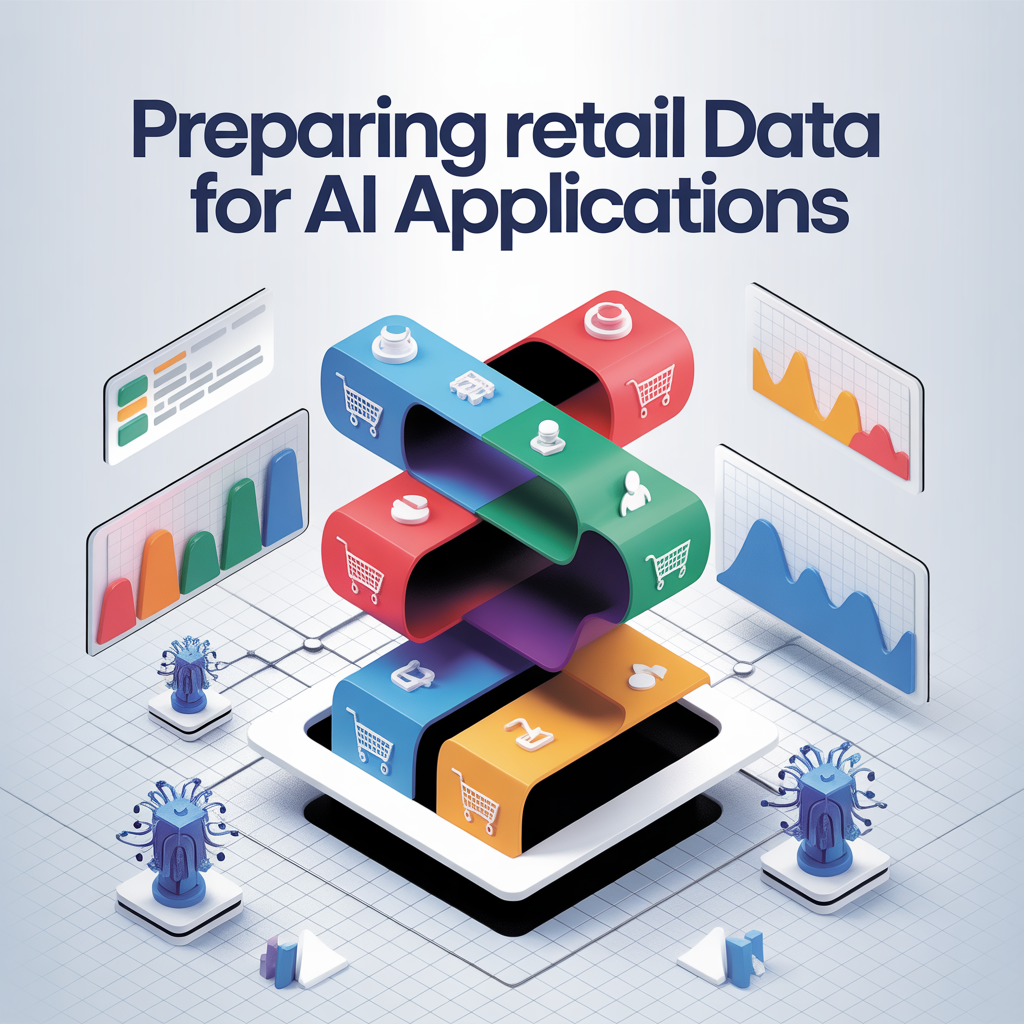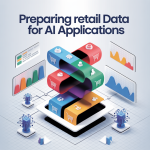
🛍️ Preparing Retail Data for AI Applications: A Comprehensive Guide
The foundation of any successful Artificial Intelligence (AI) application in the retail sector—be it for personalized recommendations, dynamic pricing, or demand forecasting—is high-quality, well-prepared data.
Raw retail data, often scattered across multiple systems, is inherently messy, inconsistent, and incomplete.1
The crucial process of data preparation, which includes cleaning, transformation, and feature engineering, is estimated to consume up to 80% of a data scientist’s time, yet it is the most critical step for ensuring the reliability and accuracy of AI models.
The Retail Data Landscape: Sources and Challenges
Retail data is vast and diverse, coming from a variety of sources that need to be unified.2
🎯 Key Data Sources
- Transactional Data: Point-of-Sale (POS) records, e-commerce transactions, returns, and billing information.
- Customer Data: Profiles, purchase history, loyalty program data, demographic information, and customer support interactions (text/call logs).3
- Product Data: Inventory levels, SKUs, product descriptions, images, and supplier details.
- Marketing/Behavioral Data: Website clickstream data, social media sentiment, ad campaign performance, and email engagement.4
- External/Contextual Data: Local weather, competitor pricing, economic indicators, and public holidays/events.5
🚧 Common Data Preparation Challenges
- Data Fragmentation: Information resides in silos (e.g., POS, CRM, ERP, website logs), making a unified customer view difficult.6
- Poor Data Quality: Inaccuracies, inconsistencies, and duplicates are rampant, especially when combining data from different legacy systems.7
- Data Volume and Velocity: The sheer scale and real-time nature of retail data (especially clickstream data) demand robust, scalable infrastructure.8
- Privacy and Compliance: Sensitive customer data requires strict adherence to regulations like GDPR and CCPA, necessitating anonymization or tokenization.9
🧹 The Data Preparation Pipeline: Essential Steps
The process of preparing retail data for AI is a multi-stage pipeline designed to ensure the data is valid, accurate, complete, consistent, and uniform.
1. Data Cleaning and Validation
Data cleaning is the first and most fundamental step, ensuring the integrity of the dataset.10
- Handling Missing Values: Missing data (null values) must be addressed to prevent model bias.11 Common techniques include:
- Imputation: Filling missing numerical values with the mean, median, or a specific constant (e.g., 0).12
- Imputation: Filling missing categorical values with the mode or a ‘Missing’ category.13
- Deletion: Removing rows or columns with missing data if the missing data is negligible and randomly distributed.14
- Outlier Detection and Treatment: Identifying data points that deviate significantly from other observations (e.g., a massive one-time purchase). Outliers can skew model training and are often handled by:
- Removal: Removing them if they are clear data entry errors.
- Capping: Replacing extreme values with a predetermined maximum or minimum threshold.
- Standardization and Deduplication:
- Deduplication: Identifying and merging duplicate records, especially for customer profiles or product listings.15
- Structural Correction: Fixing inconsistent text entries (e.g., unifying “N/A” and “Not Applicable,” or fixing spelling/capitalization errors like “T-shirt” vs. “Tshirt”).16
2. Data Transformation and Encoding
Once clean, the data must be transformed into a numerical format that machine learning algorithms can process efficiently.
- Encoding Categorical Variables: Transforming text categories into numerical representations:17
- One-Hot Encoding: Creating a binary column for each category (e.g., a “Color” column with values “Red,” “Blue” becomes three binary columns:
Color_Red,Color_Blue,Color_Green).18 This is common for nominal data. - Label Encoding/Ordinal Encoding: Assigning a unique integer to each category (e.g., “Small” = 1, “Medium” = 2, “Large” = 3).19 This is suitable for ordinal data where order matters.
- One-Hot Encoding: Creating a binary column for each category (e.g., a “Color” column with values “Red,” “Blue” becomes three binary columns:
- Feature Scaling (Normalization/Standardization): Numerical features often exist on different scales (e.g., price ranges from 1 to 1000, while a rating is 1 to 5).20 Scaling prevents features with larger magnitudes from unfairly dominating the model:21
- Normalization (Min-Max Scaling): Scales data to a fixed range, typically between 0 and 1.22
- Standardization (Z-Score Scaling): Rescales data to have a mean (mu) of 0 and a standard deviation (sigma) of 1, often preferred for models sensitive to feature variance.25 The formula for standardization is:
z = \frac{x – \mu}{\sigma}
- Handling Text Data: For product descriptions, reviews, or social media posts, natural language processing (NLP) techniques are required:
- Tokenization: Breaking text into words or phrases (tokens).26
- Normalization: Lowercasing and removing punctuation/stop words.27
- Vectorization: Converting tokens into numerical vectors using methods like TF-IDF or Word Embeddings.
3. Feature Engineering
Feature engineering involves using domain knowledge to create new input variables (features) from existing data, which significantly improves model performance.28
- Temporal Features: Deriving information from timestamps, crucial for time-series forecasting:
- Examples: Day of the week, hour of the day, month, days since the last purchase, and time until the next holiday.
- Aggregated Customer Features (RFM): Creating metrics that summarize customer behavior:
- Recency: Days since the last transaction.
- Frequency: Total number of transactions.
- Monetary Value: Total spend.
- Interaction Features: Combining two or more existing features to capture non-linear relationships:29
- Example: Creating a “Discounted_High_Value_Item” feature by multiplying a binary
Is_Discountedfeature with aPricefeature.
- Example: Creating a “Discounted_High_Value_Item” feature by multiplying a binary
- Dimensionality Reduction: Reducing the number of features to manage complexity and prevent overfitting, using techniques like Principal Component Analysis (PCA) or Feature Selection (e.g., removing highly correlated features).30
🛠️ Best Practices for Retail Data Governance
To ensure a continuous supply of high-quality data for your AI applications, establishing robust governance is essential.31
- Implement a Unified Data Strategy: Break down organizational silos.32 Use Master Data Management (MDM) to create a single, authoritative “source of truth” for core entities like Customer and Product.33
- Automate the Pipeline: Manual data preparation is slow and error-prone.34 Use automated ETL (Extract, Transform, Load) or ELT pipelines to ensure real-time data ingestion, cleaning, and transformation.
- Prioritize Data Freshness: For use cases like dynamic pricing and real-time recommendations, ensure your data pipeline can handle the high velocity of data and process it with minimal latency.
- Ensure Compliance: Establish clear access controls and employ techniques like data masking and anonymization to protect Personally Identifiable Information (PII) while still making the data useful for training models.35
- Continuous Monitoring: Data quality can degrade over time.36 Implement automated checks and audits to flag anomalies and inconsistencies, and be prepared to retrain models as customer behavior and market conditions shift.37
By meticulously cleaning, transforming, and enriching their data, retailers can move beyond simple analytics to build powerful, accurate, and profitable AI applications that drive the future of the industry.


